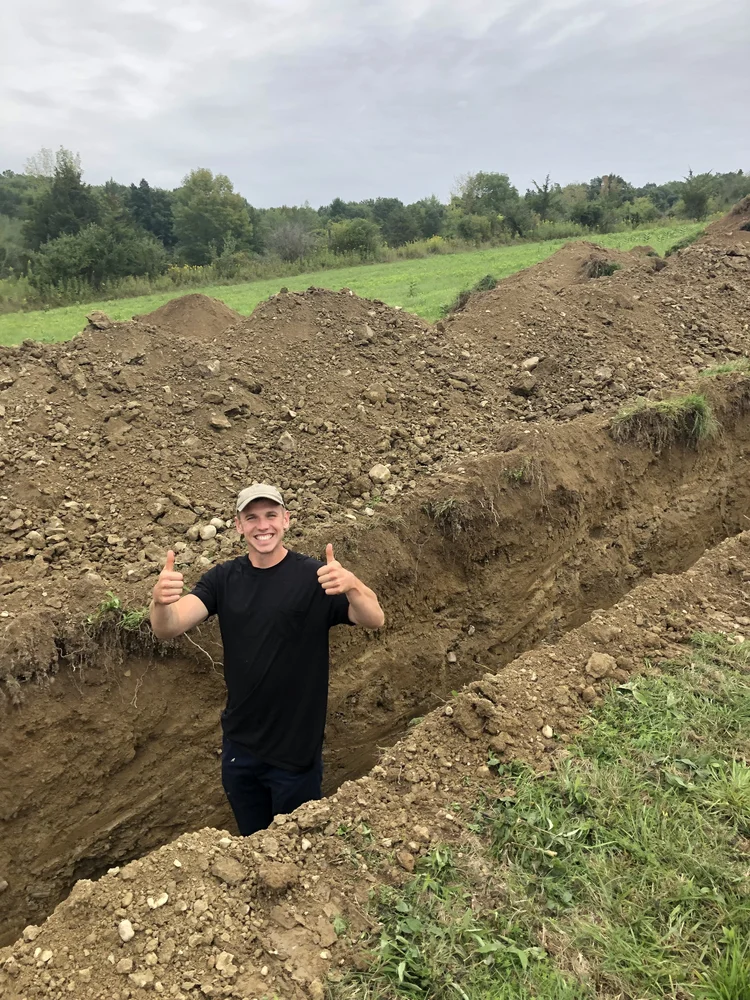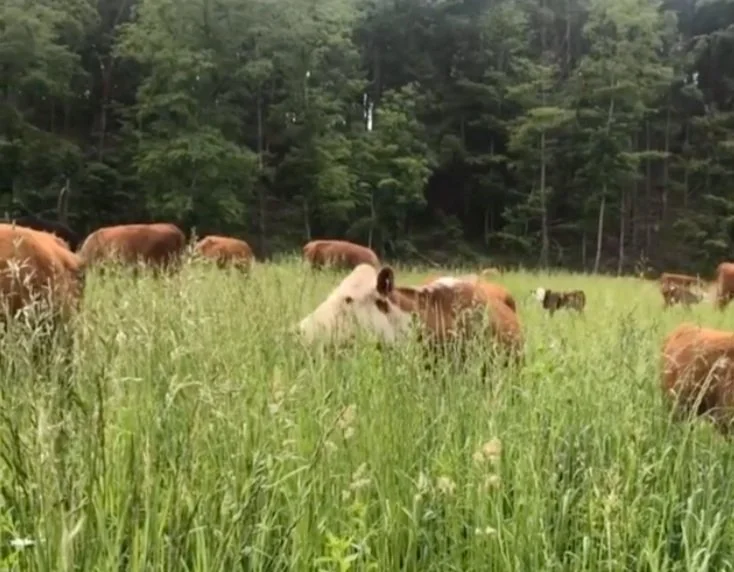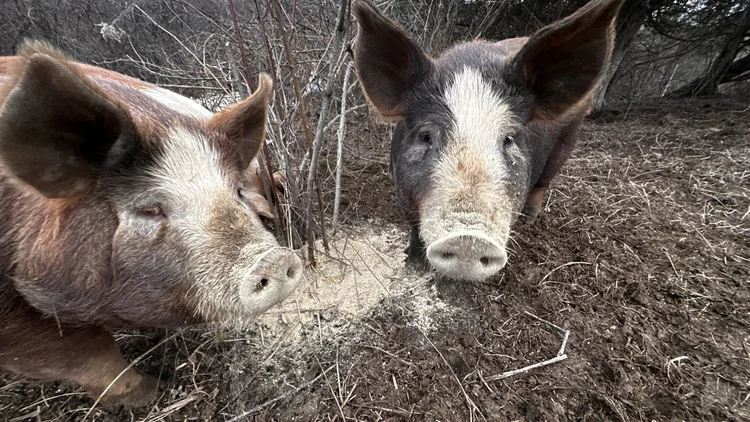Your basket is empty
Already have an account? Log in to check out faster.
Already have an account? Log in to check out faster.

We’re taking this season by storm with a unique new beef herd, 30+ piglets, and continued growth on the horizon. As this is our first newsletter, it will be a bit longer than usual to give you the full picture of our operations and future here at Northaven Farm.
Northaven Pastures is a family endeavor; comprised of myself, my wife Zoe, step-brother Eric, and parents Kim & Sue Sippel (don’t forget our Director of Predator Management, Rudy!). We are entering our 4th year of full time farming and have recently welcomed a 7th member to our Northaven family— our beautiful daughter Shiloh.
 A bit about me and how we’ve ended up here- After studying ecology at SUNY New Paltz, I learned that our ecosystems across the world are not what they were 1,000 years ago. Through clear cutting forests, the extinction of large megafauna across the world and more recently the implementation of chemical farming; our native habitats have been broken. In short, as my professor once said, “We broke the woods”. New York used to be something we never see anymore- an Oak Savanna. Meaning instead of untouched land becoming a thick patch of trees, there used to be much larger trees with forage between them. Forage that was maintained by large herds of deer, elk, and wood bison (yes, NY had bison), who were managed and moved by black bear, bobcat, lynx, fox and cougars.
A bit about me and how we’ve ended up here- After studying ecology at SUNY New Paltz, I learned that our ecosystems across the world are not what they were 1,000 years ago. Through clear cutting forests, the extinction of large megafauna across the world and more recently the implementation of chemical farming; our native habitats have been broken. In short, as my professor once said, “We broke the woods”. New York used to be something we never see anymore- an Oak Savanna. Meaning instead of untouched land becoming a thick patch of trees, there used to be much larger trees with forage between them. Forage that was maintained by large herds of deer, elk, and wood bison (yes, NY had bison), who were managed and moved by black bear, bobcat, lynx, fox and cougars.
With our cattle, pigs and electric fence now instead of the wood bison and predators, we can recreate the same ecological abundance through good and thoughtful management.
We first found what is now known as Northaven Farm in March of 2022 after three long years of searching for the perfect piece of land. We completed our purchase in July, and have been living and working on the property full time since November. Our master plan for the businesses and farm is extensive, exciting, and daunting all at once- but we have to start with the basics first. As a livestock farmer the three things I think about when getting our land up, running and restored are: fence, water and forage.
Fence is important because, well, it’s not a good strategy to allow our animals on our neighbors’ properties for starters. On a regenerative farm, fencing goes far beyond just keeping animals on our plot. Fencing is the bread and butter of what we do, as we use our animals to impact the land positively.  Our methodical control of where animals are, for how long and how large of an area directly impacts how healthy our land, animals and food are. The general principal being: Intense impact to the land for a short period of time, followed by the longest rest possible creates abundantly healthy pastures and woodlands. We use electric fencing because it is the simplest way to be the most adaptable in our land management.
Our methodical control of where animals are, for how long and how large of an area directly impacts how healthy our land, animals and food are. The general principal being: Intense impact to the land for a short period of time, followed by the longest rest possible creates abundantly healthy pastures and woodlands. We use electric fencing because it is the simplest way to be the most adaptable in our land management.
 So, we’ve established that fencing matters yet we create a problem when we rotate and move animals in this fashion. Where is the water source? After spending hours each day hauling water with a wagon at the last farm I managed, we knew that solving this problem was one of our first and highest priorities. We decided to make a substantial investment in making water accessible everywhere on this farm. We installed in over 2,500 feet of buried water line, as well as a 500’ well and solar powered well pump this past summer, when we first arrived on the farm. In order for our solar powered well pump to operate on the cloudiest of days while still remaining true to our clean energy approach, we are installing a battery powered generator. This generator uses the same solars panels to charge a large battery bank which the well will draw on when the sun isn’t shining strong enough for direct solar power. Here are some photos below of these systems being installed.
So, we’ve established that fencing matters yet we create a problem when we rotate and move animals in this fashion. Where is the water source? After spending hours each day hauling water with a wagon at the last farm I managed, we knew that solving this problem was one of our first and highest priorities. We decided to make a substantial investment in making water accessible everywhere on this farm. We installed in over 2,500 feet of buried water line, as well as a 500’ well and solar powered well pump this past summer, when we first arrived on the farm. In order for our solar powered well pump to operate on the cloudiest of days while still remaining true to our clean energy approach, we are installing a battery powered generator. This generator uses the same solars panels to charge a large battery bank which the well will draw on when the sun isn’t shining strong enough for direct solar power. Here are some photos below of these systems being installed.
| Though the solar power supply chain is deeply flawed, we are doing our best to use clean energy practices and power our entire water distribution system with solar power from our solar array, a solar powered battery backup. |
|
The most important thing I’m thinking about all year round is our forage— the resource that our cattle live off of exclusively and the resource that our pigs receive the majority of their nutrition from. As mentioned above, large swath of our land was continuously hayed for years straight without any organic matter being put back into the soil. This strips our land of minerals and nutrients, making our grasses less nutritious. How can we solve this issue? After all, no matter how excellent our livestock genetics are, if they are not eating a diet filled with nutrients, they will not perform well.

How we approach this is through a thorough mineral program that gives our animals all of the micro nutrients and minerals that may be lacking in our current soil while, putting those nutrients into the ground here. Our main supplemental mineral feeds are Redmonds Sea Salt and Sealife Kelp. The combination of these two organic mineral supplements cover all of the bases for our animals. When those minerals have played their role in our animal’s biology, they will export them into our soil through their urine and manure; feeding our ground what it has been getting stripped of and helping our forage be more nutritious for the next time the stock grazes that grass.
With Heritage as the centerpiece of our mission statement, we wanted to talk about the specifics of our herd: it’s acquisition and our breeding plans for the future. We are making substantial investments into some of the most sought after animals and rarest breeding stock available. We are excited to share these animals and their progeny with you for years to come.
We are taking a bi-directional approach with our pig enterprise through two 100% organic, distinct heritage breeds. Both of these paths include supplementing our pigs’ high forage diet with locally grown organic grains that are both corn free and soy free. This custom made ration includes: wheat, field peas, and barley developed and blended by Stonehouse Grain.
Ecologically, pigs some of the best solar powered land clearing tools that money can buy. Our farm is currently filled with brush and thicket along the edges, and our pigs have been steadily clearing out a lot of these invasive areas that we want to replace with grasses and healthy trees.
The first breed we have been raising are our Tamworth pigs; a breed hailing from England. These animals are known to be “long and lean” and these pigs have historically been raised in woodlands across Europe. Tamworth have been known to produce a high volume of muscle mass, and take 6 months from birth to reach their market weight of about 250 lbs. Our pigs have big appetites and grow quickly, as each pig requires roughly 10 lbs. of grain per day to reach this weight.
Our initial Tamworth crop has been sourced from Buttonwood Hollow Farm, with some additional pigs coming from them this spring! We currently have four Tamworth on the farm that are available for purchase now on Our Store, They will be processed and ready by late March. After that, our next batch of six will be processed and available this summer!

In May we are welcoming 30 new Tamworth pigs from 100% organic Misty Brook Farm. Although a majority of these are spoken for to a single customer, 10 of these animals will be the foundation of our Tamworth program. We will be producing a fall crop with 5 of these animals, and starting our breeding program with the remaining 5. As we continue to get our feet settled with our pork production pipeline, we will be refining our process with a goal of providing bulk pork quarterly. We hope to have this in place in the next 12 to 18 months; as slow, steady, and “doing it right” is our focus.
The flagship breed we have been investing in is our Kune Kune, which hail from the grasslands of New Zealand. In the 1990s this breed was nearly extinct as it was not adaptable to the confinement model of pig raising. However recently this breed has made a significant comeback within the last 20 years with small scale organic pig producers all over the world who have been attracted by their high value. Known as the “grazing pig”, the Kune Kune does not root the same way our Tamworths do- they graze the land much like a cow and thrive off of almost exclusively forages. This is exciting for the future of our farm; as the cost of fuel and grain prices go up we can be resilient in not having to rely heavily on off farm inputs such as grain.

We have continued our commitment to heritage breeds with the purchase of 4 AKKPS registered Kune Kunes from two renown breeders; Bel Canto Farm & Heritage Haus Farm. These animals are the foundation of our Kune breeding program here at Northaven; a gilt (Mira), our boar (Gus), and two weanlings, (Mona and Mika). Mira is currently pregnant and expected to farrow any day now! Mona and Mika are steadily growing and we will breed them with Gus next year.
This breed provides a rare opportunity for our customers to have access to the incredibly special meat that these animals produce. These pigs are known for their marvelous fat content, as it takes them 12-14 months to reach market weight; which they do so on as little as one pound of grain per day. When we get closer to offering these products in our store, we will have a special newsletter centered around an in-depth look at this breed and their unique characteristics.
We are currently taking deposits for our Tamworth pork for March pickup, and will begin offering our special Kune Kune crop later this year.
We are taking a similar dual approach with our cattle. Although we are focusing on a single breed, we are beginning our herd with two different groups. One to help us produce meat now, the other as an investment for the future of our farm. We only ever purchase animals from people who use the same management practices as we do, and share in the same vision we have outlined above.
We are purchasing our calf crop from our good friend Ryan Martens of Grassroots Farm. He is a meticulous farmer who shares in our values and passion for Red Devon breeding. Ryan has built a loyal customer base serving the Hudson Valley with some of the finest beef in the area.

We are privileged to continue his legacy with his herd, and look forward to expanding its size on our land. Our fall beef crop will be comprised of animals in this initial purchase. We will have 7 weanlings, and 5 feeders that we will beef and offer to our customers this fall. Bulk Beef Depositsare currently available on our online store!
Simultaneously we are purchasing some of the best breeding stock in the world from Mike Scannell of Harrier Fields Farm. Mike is a farmer in Schodack Landing who has been line breeding Red Devons for over 30 years. He bought these animals from one of the oldest most well preserved cattle herds in Australia several decades ago, and his continued passion for line breeding and genetics shows as his herd is one of the most highly sought after in the Northeast. Mike is a mentor to me and we are honored to be able to expand upon the hard work he has put into his genetics over decades. We have purchased a bull and a heifer which Mike has hand selected for us, which will serve as the foundation to our Red Devon breeding program in the coming years.
Thank you for joining us on this journey! We look forward to our coming season ahead, and to sharing in the growth of Northaven Farm together with you. Our farm could not exist without our customers supporting us in our effort to build ecosystems, soil, community and real food.
If you ever have any questions, want to chat, or are interested in seeing our operation first hand please don’t hesitate to give us a call or drop us an email!
Bennett, Zoe, Shiloh, Sue, Kim, Eric & Rudy